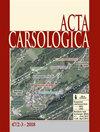Understanding the temporal variation of flow direction in a complex karst system (Planinska Jama, Slovenia)
IF 1.1
4区 地球科学
Q4 GEOSCIENCES, MULTIDISCIPLINARY
引用次数: 6
Abstract
Karst aquifers are abundant, but vulnerable water resources. Therefore, a deeper understanding of possible mechanisms that determine the properties of karst springs is crucial. In this work, we present an example of Unica Spring and Malni Spring, the two main outlets of a large karst system in the Notranjska karst region, Slovenia. Although the two springs share same catchment area, the flow distribution between them shows an interesting behaviour: At low-flow conditions, Malni Spring is the main outlet, while Unica spring receives almost no water. During high water events, discharge of Malni Spring stays limited and Unica Spring becomes the main outlet. We relate these observations to the local geometry of the channels and breakdowns in the remote part of the Planinska Jama (Planina Cave), called Mysterious Lake. There, waters from Rakov Škocjan and Javorniki aquifer merge and further diverge to both springs. At low water conditions, the outflow towards the Unica Spring is restricted by the breakdown, so that most of the inflow is directed towards the Malni Spring. With increasing recharge, the level in Mysterious Lake rises until the water starts to flow over the breakdown along a system of large channels (Rak Branch of Planinska Jama) to the Unica Spring. The breakdown level keeps the hydraulic head and the flow towards Malni Spring limited. To verify this scenario, a hydraulic conduit model was made based on the known and predicted channels, and inflows calculated from the historical data of discharge measurements at related springs and ponors. An inversion procedure was used to obtain a satisfactory fit to the observed discharge data and to constrain the selected model parameters. The model accurately reproduced the observed discharge behaviour under low- andhigh-flow conditions.了解复杂喀斯特系统中水流方向的时间变化(Planinska Jama,斯洛文尼亚)
喀斯特含水层丰富,但水资源脆弱。因此,深入了解决定岩溶泉性质的可能机制至关重要。在这项工作中,我们提出了一个尤尼卡泉和马尔尼泉的例子,这是斯洛文尼亚诺特兰斯卡喀斯特地区一个大型喀斯特系统的两个主要出口。虽然这两个泉共享同一集水区,但它们之间的流量分布却显示出一个有趣的现象:在低流量条件下,Malni泉是主要的出水口,而Unica泉几乎没有水。在高水位期间,马尔尼泉的流量保持有限,尤尼卡泉成为主要出口。我们将这些观察结果与Planinska Jama (Planina洞穴)偏远部分的通道和破裂的局部几何形状联系起来,称为神秘湖。在那里,来自Rakov Škocjan和Javorniki含水层的水汇合,并进一步分流到两个泉。在低水位条件下,向尤尼卡泉的流出受到破裂的限制,因此大部分流入都指向马尔尼泉。随着补给的增加,神秘湖的水位上升,直到水开始沿着一个大通道系统(Planinska Jama的Rak分支)流向尤尼卡泉。故障水平使液压水头和流向马尔尼弹簧的流量受到限制。为了验证这一情景,根据已知和预测的渠道,以及根据相关弹簧和河流的流量测量历史数据计算的流入量,建立了水力管道模型。采用反演方法对实测放电数据进行拟合,并对所选模型参数进行约束。该模型准确地再现了在低流量和高流量条件下观察到的流量行为。
本文章由计算机程序翻译,如有差异,请以英文原文为准。
求助全文
约1分钟内获得全文
求助全文
来源期刊

Acta Carsologica
地学-地球科学综合
CiteScore
1.50
自引率
14.30%
发文量
0
审稿时长
>12 weeks
期刊介绍:
Karst areas occupy 10-20 % of ice-free land. Dissolution of rock by natural waters has given rise to specific landscape and underground. Karst surface features and caves have attracted man''s curiosity since the dawn of humanity and have been a focus to scientific studies since more than half of millennia.
Acta Carsologica publishes original research papers and reviews, letters, essays and reports covering topics related to specific of karst areas. These comprise, but are not limited to karst geology, hydrology, and geomorphology, speleology, hydrogeology, biospeleology and history of karst science.
 求助内容:
求助内容: 应助结果提醒方式:
应助结果提醒方式:


